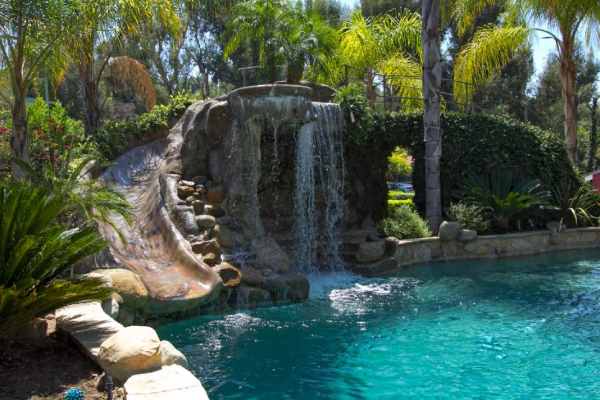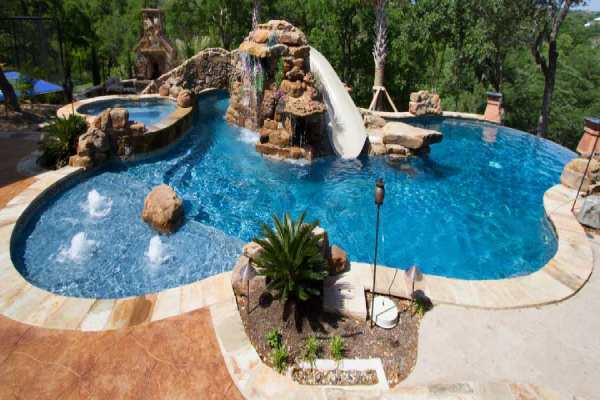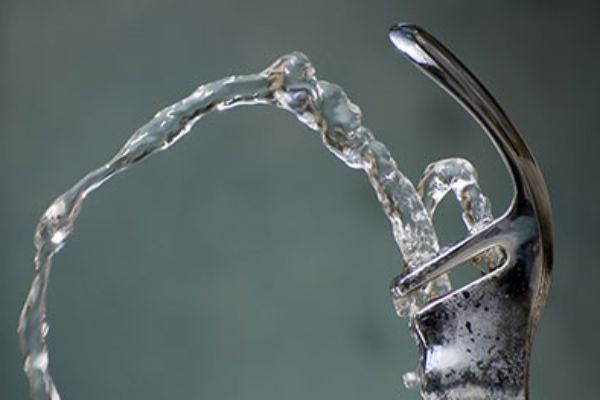How To Keep Fountain Water From Evaporating [Causes & Fixes]
It’s a known fact that fountains are a wonderful addition to any outdoor setting. However, the evaporation of water from fountains is a common problem that many fountain owners experience.
Because of the need for constant replenishment, water use may rise as a result. If you want to keep your fountain looking its best for as long as possible, you need to know what’s causing the water to evaporate and how to stop it.
In this blog post, we’ll take a look at what causes your fountain water to evaporate, and how to keep fountain water from evaporating. Now, without wasting time, let’s jump right into it.
Cracks and leaks
Your fountain can lose water because of cracks and leaks. This issue can arise for a variety of reasons and lead to serious fountain water loss if they aren’t fixed quickly.
When we talk about cracks and leaks in a fountain, we’re referring to holes or gaps in your fountain through which water can seep out.
The fountain’s basin, walls, pipes, and joints are all potential locations for them. Wear and tear over time, severe weather, and sloppy workmanship can all contribute to the formation of cracks.
However, leaks can occur due to improper installation, broken seals, or rusty pipe fittings. Careful inspection and easy testing can help you find the source of any leaks or damage to your fountain.
The fountain can be turned off and left alone for a day as one option. If the water level lowers by more than an inch, then there is probably a leak.
Dry cracks, which may seem like white lines on concrete fountains, can also be seen after letting the fountain sit idle for a week without the pump and nozzle.
The presence of leaks or cracks must be established before any action can be taken to repair them.
A sealant might be an efficient remedy for tiny cracks because sealants’ primary function is to prevent water from leaking by sealing cracks and crevices.
You have the option of applying the sealant to the entire fountain or only the affected region. If your fountain is made of concrete, stone, or fiberglass, use a sealer made of those materials.
If the crack is extensive or the leak persists after using a sealant, however, it is best to have a professional take a look at the situation.
Overspray
When water from a fountain sprays or splashes outside of its intended region, this is known as overspray, and it results in fountain water loss. It’s another reason why your fountain loses water.
Overspray on fountains can be caused by a number of different factors, such as improper adjustment of the spray nozzles. This can cause them to spray water well beyond the intended region.
Overspray can also be caused by the water pressure being too high. The water can be propelled too far from the fountain’s pool if the pressure is too high.
Obviously, the next question on your lips is, “How do I know if my pond is losing water through overspray? Now, here’s the answer;
If water is accumulating in a lot of places around the fountain, it may be due to overspray.
Overspray can create water stains on adjoining surfaces, such as buildings, pathways, and even vegetation.
If your fountain is losing water through overspray, the fountain’s nozzles should be adjusted according to manufacturer instructions or by an expert.
Overspray can also be minimized by directing the water spray in the desired direction and adjusting its height and width.
Water flow issues
This occurs whenever the normal flow of water within a fountain is impeded in any way. These problems, which can damage the fountain’s functionality and appearance, range from insufficient water flow to complete obstruction.
When the fountain’s water flow is interrupted, the water evaporates more quickly because it isn’t contained effectively.
Problems with the pump, which is responsible for recirculating water through the fountain, are a common source of water flow issues.
Problems with pumps can be caused by a faulty motor, a clogged impeller, or lack of electricity. These issues may cause water flow disruptions, which in turn may increase evaporation.
The misalignment or damage of the tubes that carry water from the pump to the top of the fountain is another common problem with fountains.
Disrupted water flow can occur if the tubes are not properly joined or have developed fractures or holes. These holes not only cause fountain water loss but also speed up the rate at which the fountain’s water evaporates.
If the water flow from your fountain has diminished or stopped altogether, it may be a symptom of a problem with the water supply. Water seepage at joints or crevices also indicates water flow issues.
To resolve this issue, make sure there isn’t any obvious damage to the pump or clogged impellers. If the impeller needs to be cleaned or replaced, do so. Also, you have to be sure that your pump has a sufficient and operational power supply.
Wind
The evaporation of fountain water due to wind power is so obvious that it hardly needs explanation. The wind plays a significant role in preventing the water from returning to the fountain’s water supply as it splashes in the air. It’s a well known reason why your fountain loses water.
The wind, whether light or strong, quickly sweeps the droplets away, where they quickly disperse into the air. The water in the fountain evaporates in large part due to this relentless spraying.
It can be difficult to prevent fountain water loss due to wind. Although it makes sense to place the fountain next to the house so that it blocks the wind coming from that direction, this strategy is not completely effective.
It’s impossible to exert total control over the weather, as the wind might come from a variety of directions.
The good news is that you can take practical steps to reduce the amount of water lost through wind evaporation.
Purchasing a cover for your fountain is a great way to keep it safe when it’s not in use. Covering your fountain tightly creates a screen that blocks the wind from dispersing the water through splashes.
Another way to save water is to switch off your fountain when it’s not in use. Doing so prevents the water from constantly splashing and reduces the likelihood that the wind will blow it away.
This method of conserving water assures that your fountain will continue to be a beautiful addition to your garden or outdoor space.
Fountain Architecture
Your fountain’s design or construction, typically known as fountain architecture, can lead to water loss or evaporation.
Your fountain may not be able to hold water anymore, necessitating frequent refilling and wasting resources.
There are numerous issues that will cause fountain water loss, and these include shallow basins. When a fountain’s basin isn’t deep enough, the water in it evaporates too quickly.
Water loss is also possible in fountains with insufficient edge height, especially in windy weather or when the fountain is in use. Water loss can occur quickly if it is not contained properly.
There are ways you can resolve the issues, and these include ensuring appropriate water flow, aeration, and less splashing by improving the circulation system if the fountain’s current one is inefficient or antiquated.
Hiring a specialist who specializes in water features, such as a fountain expert or an architect, is another option. They’ll be able to examine the fountain’s construction and single out the leaky parts of the fountain’s design.
You can also resolve this by paying attention to your fountain’s water line and avoiding filling it past that point.
Plant life
Water is essential to plant life, just as it is to human and animal life. So, it is quite likely that plants growing in or around your fountain are the cause of the rapid water evaporation.
You know, plants can contribute to your fountain’s water loss by absorbing little drops that land on their leaves.
The splashing and cascading of your fountain send tiny droplets into the air, which can be caught and used by neighboring plants.
This may not seem like a big deal at first, but when more than one plant is doing it, it can add up to a significant amount of water being lost.
Fortunately, there are easy measures you can take to lessen these impacts. The first and most obvious step is to prune any plants that have taken root on or around your fountain.
You can also reduce water waste by maintaining and trimming the plants you plan to keep. It is crucial to prevent the greens from coming into contact with the water at any point.
By removing overhanging limbs and leaves, you can limit the rate at which water evaporates from your fountain
Fountain Composition
The fountain’s ability to hold water is influenced by its composition. Water seepage and evaporation can be problems for some materials more than others.
Small pores in porous stones used for fountains let water and air circulate freely. Water appears to be escaping, but it is actually being absorbed by the stone’s fissures and voids.
With careful observation, you can determine whether your fountain is experiencing a composition problem or not.
If you notice that your fountain’s water level is usually low even in the absence of leaks or other damages, then the materials your fountain is made of may be the culprit.
Fortunately, there are techniques you can use to reduce fountain water loss in this type of fountain.
A sealer applied to the fountain’s surface is one possible option. Water may infiltrate through the pores of many different materials, but sealants are made to stop that.
If you use a good sealer on your fountain, you can prevent water from being absorbed and lost to evaporation. If you want your fountain to last, it’s crucial that you choose a sealant that is appropriate for its construction.
To get the best results from the sealer, make sure the fountain is completely dry before applying it.
Spread the sealant all over the fountain, paying special attention to the fractures and porous spots. Before refilling the fountain with water, be sure the sealant has had enough time to dry and cure.
Evaporation
Water loss from fountains is largely attributable to evaporation, a commonplace and natural phenomenon.
As we all know, evaporation is the process by which liquid water turns into water vapour as part of the water cycle.
You know, when water in a fountain is heated by the sun’s rays to a temperature of 100 degrees Celsius (212 degrees Fahrenheit), some of it turns into vapour and rises into the air.
A typical fountain will lose around an inch of water to evaporation every week. Due to natural evaporation, your fountain may appear to be leaking due to the significant amount of water lost.
The following solutions may be useful in dealing with fountain water loss due to evaporation;
The fountain should be moved to a shadier location if at all possible. The rate of evaporation can be lowered by limiting exposure to sunlight. Not all fountains, especially those permanently fixed into the ground or buildings, are easily relocated, though.
If relocating your fountain isn’t an option, you may always build a shaded area around it. To prevent the water from getting too hot during the middle of the day, strategically position umbrellas, awnings, or pergolas.
This method reduces the effects of the high temperatures and helps prevent water loss due to evaporation.
Conclusion
Avoiding water loss due to evaporation is crucial for the longevity of your fountain, its beauty and its ability to conserve water.
Fountain water loss can be reduced by identifying the factors that contribute to it and taking corrective measures, such as installing a cover over the fountain or thinking about alternative fountain designs.
It is also important to check the water level in your fountain on a regular basis so that you can see any problems early and fix them.
By using the techniques in this blog on “how to keep fountain water from evaporating”, you will be able to protect your fountain’s water supply while still appreciating its soothing ambience.
FAQs
You can prevent your fountain water from evaporating by putting your fountain somewhere shady to reduce the amount of water lost to evaporation.
Although there are chemicals available for purchase that claim to slow the rate at which water evaporates from fountains, it is not recommended that you use them.
The fountain needs to be washed down and dried completely before being sealed. To stop water from leaking through porous surfaces, seal the fountain using a sealer made for the material it is made of.

![Here’s Why Your Fountain Loses Water [9 Reasons & Quick Fix]](https://pondmemo.com/wp-content/uploads/2023/11/why-your-fountain-loses-water-IMG_1.jpg)

![How to Stop a Fountain from Splashing [Indoor & Garden]](https://pondmemo.com/wp-content/uploads/2023/06/how-to-stop-a-fountain-from-splashing-1-IMG.jpg)


![Wiring an Outdoor Water Fountain – [Safe DIY Guide]](https://pondmemo.com/wp-content/uploads/2023/08/wiring-an-outdoor-water-fountain-IMG_1.jpg)